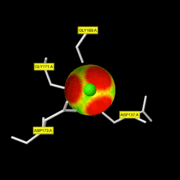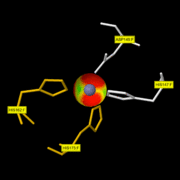Sandbox Reserved 1125
From Proteopedia
(Difference between revisions)
| Line 73: | Line 73: | ||
== Mechanism == | == Mechanism == | ||
| - | MMP-8 is secreted as inactive proprotein and then activated after a cleavage by extracellular proteinases. Indeed, it can't be activated without removal of the activation peptide. After this protease activation, recent evidences suggest that, there is formation of an intramolecular complex between the Cysteine residue (Cys91) of the propeptide domain and essential zinc atom in the catalytic domain. It is called the ''Cysteine-switch'': it inhibits the action of MMP-8. This discovery is unprecedented in enzymology and offers the opportunity for multiple modes of physiological activation of MMP-8. Moreover, since conditions in | + | MMP-8 is secreted as inactive proprotein and then activated after a cleavage by extracellular proteinases. Indeed, it can't be activated without removal of the activation peptide. After this protease activation, recent evidences suggest that, there is formation of an intramolecular complex between the Cysteine residue (Cys91) of the propeptide domain and essential zinc atom in the catalytic domain. It is called the ''Cysteine-switch'': it inhibits the action of MMP-8. This discovery is unprecedented in enzymology and offers the opportunity for multiple modes of physiological activation of MMP-8. Moreover, since conditions are different in the diversity of cells and tissues, this may allow a metabolic flexibility in MMP activation control.<ref>PMID:2164689</ref> |
To express collagenolytic activity, MMP-8 needs to have both the catalytic and hemopexin domains. The linker peptide can position the hemopexin domain in such a way that it bends over the active site of the catalytic domain. But understanding how the Hemopexin domain assists in the cleavage of collagen is elusive.<ref>PMID:15257288</ref> Thus, the collagen would be captured between these two domains. However, the active site cannot accommodate the entire triple helix in a native state. The linker peptide would, by means of its collagen-like conformation, change the quaternary structure of the captured collagen. Interactions between proline residues of the collagenase and a specific region of the collagen would generate a “proline zipper,” resulting in destabilization of the cleavage site area of the collagen. After destabilization, one chain of the triple helix fits in the specificity pocket or <scene name='71/719866/S1prime_pocket/1'>S1' pocket</scene> to the right of the active-site zinc. At first, the Gly residue of the substrate binds the <scene name='71/719866/Catalytic_site/5'>active site</scene> thanks to the Zn2+ atom. When it binds it takes the place of unstable water molecules and establishes stabilizing interactions with the active site thanks to its C terminal part.<ref>PMID:17185359</ref> The carboxyl group of the glutamate (GLU 198 in the active site green link above) serves as a general base to draw a proton from the displaced water molecule, thereby facilitating the nucleophilic attack of the water molecule on the carbonyl carbon of the peptide scissile bond. Then, the Alanine residue of the active site makes a hydrogen bond with the NH group of the substrate. Moreover, this NH group becomes the new N-terminus after cleavage.<ref name="inhibitor">PMID:12730128</ref> | To express collagenolytic activity, MMP-8 needs to have both the catalytic and hemopexin domains. The linker peptide can position the hemopexin domain in such a way that it bends over the active site of the catalytic domain. But understanding how the Hemopexin domain assists in the cleavage of collagen is elusive.<ref>PMID:15257288</ref> Thus, the collagen would be captured between these two domains. However, the active site cannot accommodate the entire triple helix in a native state. The linker peptide would, by means of its collagen-like conformation, change the quaternary structure of the captured collagen. Interactions between proline residues of the collagenase and a specific region of the collagen would generate a “proline zipper,” resulting in destabilization of the cleavage site area of the collagen. After destabilization, one chain of the triple helix fits in the specificity pocket or <scene name='71/719866/S1prime_pocket/1'>S1' pocket</scene> to the right of the active-site zinc. At first, the Gly residue of the substrate binds the <scene name='71/719866/Catalytic_site/5'>active site</scene> thanks to the Zn2+ atom. When it binds it takes the place of unstable water molecules and establishes stabilizing interactions with the active site thanks to its C terminal part.<ref>PMID:17185359</ref> The carboxyl group of the glutamate (GLU 198 in the active site green link above) serves as a general base to draw a proton from the displaced water molecule, thereby facilitating the nucleophilic attack of the water molecule on the carbonyl carbon of the peptide scissile bond. Then, the Alanine residue of the active site makes a hydrogen bond with the NH group of the substrate. Moreover, this NH group becomes the new N-terminus after cleavage.<ref name="inhibitor">PMID:12730128</ref> | ||
Current revision
Matrix metalloproteinase-8
MMP-8, also called, Neutrophil collagenase or Collagenase 2, is a zinc-dependent and calcium-dependent enzyme mainly produced by neutrophils. It belongs to the matrix metalloproteinase (MMP) family which is involved in the breakdown of extracellular matrix in embryonic development, reproduction, and tissue remodeling, as well as in disease processes. The gene coding this family is localized on the chromosome 11 of Homo sapiens with 467 residues.[1]
is the reloading for the initial structure of the catalytic domain of MMP-8. ( Protein Data Bank ID : 2OY4 )
| |||||||||||
References
- ↑ "MMP-8 matrix metallopeptidase 8 (neutrophil collagenase)"
- ↑ "Metalloendopeptidase activity"
- ↑ 3.0 3.1 Substrate specificity of MMPs
- ↑ 4.0 4.1 4.2 Bode W, Reinemer P, Huber R, Kleine T, Schnierer S, Tschesche H. The X-ray crystal structure of the catalytic domain of human neutrophil collagenase inhibited by a substrate analogue reveals the essentials for catalysis and specificity. EMBO J. 1994 Mar 15;13(6):1263-9. PMID:8137810
- ↑ Gupta SP, Patil VM. Specificity of binding with matrix metalloproteinases. EXS. 2012;103:35-56. doi: 10.1007/978-3-0348-0364-9_2. PMID:22642189 doi:http://dx.doi.org/10.1007/978-3-0348-0364-9_2
- ↑ Verma RP, Hansch C. Matrix metalloproteinases (MMPs): chemical-biological functions and (Q)SARs. Bioorg Med Chem. 2007 Mar 15;15(6):2223-68. Epub 2007 Jan 17. PMID:17275314 doi:http://dx.doi.org/10.1016/j.bmc.2007.01.011
- ↑ 7.0 7.1 Knauper V, Docherty AJ, Smith B, Tschesche H, Murphy G. Analysis of the contribution of the hinge region of human neutrophil collagenase (HNC, MMP-8) to stability and collagenolytic activity by alanine scanning mutagenesis. FEBS Lett. 1997 Mar 17;405(1):60-4. PMID:9094424
- ↑ Hirose T, Patterson C, Pourmotabbed T, Mainardi CL, Hasty KA. Structure-function relationship of human neutrophil collagenase: identification of regions responsible for substrate specificity and general proteinase activity. Proc Natl Acad Sci U S A. 1993 Apr 1;90(7):2569-73. PMID:8464863
- ↑ Piccard H, Van den Steen PE, Opdenakker G. Hemopexin domains as multifunctional liganding modules in matrix metalloproteinases and other proteins. J Leukoc Biol. 2007 Apr;81(4):870-92. Epub 2006 Dec 21. PMID:17185359 doi:http://dx.doi.org/10.1189/jlb.1006629
- ↑ Van Wart HE, Birkedal-Hansen H. The cysteine switch: a principle of regulation of metalloproteinase activity with potential applicability to the entire matrix metalloproteinase gene family. Proc Natl Acad Sci U S A. 1990 Jul;87(14):5578-82. PMID:2164689
- ↑ Chung L, Dinakarpandian D, Yoshida N, Lauer-Fields JL, Fields GB, Visse R, Nagase H. Collagenase unwinds triple-helical collagen prior to peptide bond hydrolysis. EMBO J. 2004 Aug 4;23(15):3020-30. Epub 2004 Jul 15. PMID:15257288 doi:http://dx.doi.org/10.1038/sj.emboj.7600318
- ↑ Piccard H, Van den Steen PE, Opdenakker G. Hemopexin domains as multifunctional liganding modules in matrix metalloproteinases and other proteins. J Leukoc Biol. 2007 Apr;81(4):870-92. Epub 2006 Dec 21. PMID:17185359 doi:http://dx.doi.org/10.1189/jlb.1006629
- ↑ 13.0 13.1 Visse R, Nagase H. Matrix metalloproteinases and tissue inhibitors of metalloproteinases: structure, function, and biochemistry. Circ Res. 2003 May 2;92(8):827-39. PMID:12730128 doi:http://dx.doi.org/10.1161/01.RES.0000070112.80711.3D
- ↑ "Neutrophil collagenase"
- ↑ Nagase H, Visse R, Murphy G. Structure and function of matrix metalloproteinases and TIMPs. Cardiovasc Res. 2006 Feb 15;69(3):562-73. Epub 2006 Jan 5. PMID:16405877 doi:http://dx.doi.org/10.1016/j.cardiores.2005.12.002
- ↑ [http://www.rcsb.org/pdb/explore/explore.do?structureId=1UEA "Metalloprotease-Inhibitor Complex
- ↑ Brew K, Nagase H. The tissue inhibitors of metalloproteinases (TIMPs): an ancient family with structural and functional diversity. Biochim Biophys Acta. 2010 Jan;1803(1):55-71. doi: 10.1016/j.bbamcr.2010.01.003. , Epub 2010 Jan 15. PMID:20080133 doi:http://dx.doi.org/10.1016/j.bbamcr.2010.01.003
- ↑ Jacobsen JA, Major Jourden JL, Miller MT, Cohen SM. To bind zinc or not to bind zinc: an examination of innovative approaches to improved metalloproteinase inhibition. Biochim Biophys Acta. 2010 Jan;1803(1):72-94. doi: 10.1016/j.bbamcr.2009.08.006. , Epub 2009 Aug 25. PMID:19712708 doi:http://dx.doi.org/10.1016/j.bbamcr.2009.08.006
- ↑ 'Crystal structure of the complex between MMP-8 and a N-hydroxyurea inhibitor'
- ↑ 'Crystal structure of the complex between MMP-8 and a non-zinc chelating inhibitor'
- ↑ "Extra Binding Region Induced by Non-Zinc Chelating Inhibitors into the S1′ Subsite of Matrix Metalloproteinase 8"
- ↑ Savill NJ, Weller R, Sherratt JA. Mathematical modelling of nitric oxide regulation of rete peg formation in psoriasis. J Theor Biol. 2002 Jan 7;214(1):1-16. PMID:11786028 doi:http://dx.doi.org/10.1006/jtbi.2001.2400
- ↑ Larochelle C, Alvarez JI, Prat A. How do immune cells overcome the blood-brain barrier in multiple sclerosis? FEBS Lett. 2011 Dec 1;585(23):3770-80. doi: 10.1016/j.febslet.2011.04.066. Epub, 2011 May 4. PMID:21550344 doi:http://dx.doi.org/10.1016/j.febslet.2011.04.066
- ↑ Westermarck J, Kahari VM. Regulation of matrix metalloproteinase expression in tumor invasion. FASEB J. 1999 May;13(8):781-92. PMID:10224222
- ↑ Liu KZ, Hynes A, Man A, Alsagheer A, Singer DL, Scott DA. Increased local matrix metalloproteinase-8 expression in the periodontal connective tissues of smokers with periodontal disease. Biochim Biophys Acta. 2006 Aug;1762(8):775-80. Epub 2006 Jul 22. PMID:16928431 doi:http://dx.doi.org/10.1016/j.bbadis.2006.05.014
- ↑ Balbin M, Fueyo A, Knauper V, Pendas AM, Lopez JM, Jimenez MG, Murphy G, Lopez-Otin C. Collagenase 2 (MMP-8) expression in murine tissue-remodeling processes. Analysis of its potential role in postpartum involution of the uterus. J Biol Chem. 1998 Sep 11;273(37):23959-68. PMID:9727011
- ↑ Brand KH, Ahout IM, de Groot R, Warris A, Ferwerda G, Hermans PW. Use of MMP-8 and MMP-9 to assess disease severity in children with viral lower respiratory tract infections. J Med Virol. 2012 Sep;84(9):1471-80. doi: 10.1002/jmv.23301. PMID:22825827 doi:http://dx.doi.org/10.1002/jmv.23301
- ↑ Gao M, Nguyen TT, Suckow MA, Wolter WR, Gooyit M, Mobashery S, Chang M. Acceleration of diabetic wound healing using a novel protease-anti-protease combination therapy. Proc Natl Acad Sci U S A. 2015 Dec 8;112(49):15226-31. doi:, 10.1073/pnas.1517847112. Epub 2015 Nov 23. PMID:26598687 doi:http://dx.doi.org/10.1073/pnas.1517847112


